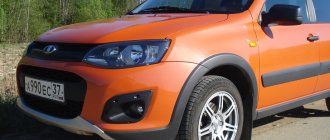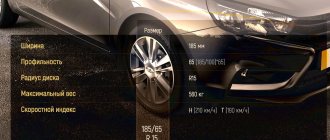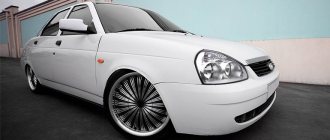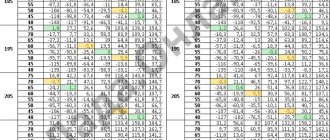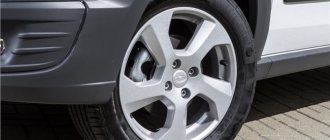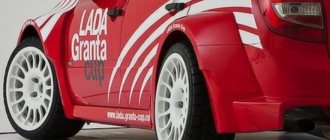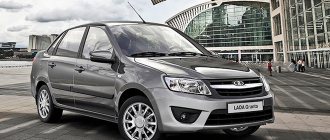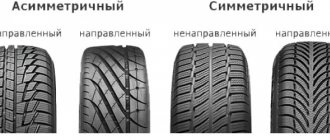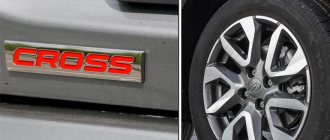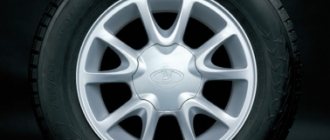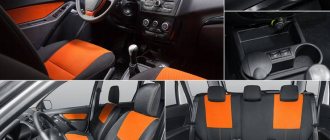July 22, 2015 Lada.Online 351 527 69
Tire size is an important parameter that affects the behavior of a car on the road. In the review we will tell you about the size of tires and wheels of the 2nd generation Lada Kalina allowed by the manufacturer. We will also consider what these parameters influence during operation.
Help me choose winter tires
It's getting colder... We need to prepare for winter.
So it’s time to change into winter tires. But which one to choose? After surfing the Internet and browsing local stores, I turned my attention to the following tires (prices in my city):
Continental ContiIceContact
3440 rub.
Nokian Hakkapeliitta 7
3910 r.
Nokian Hakkapeliitta 5
RUR 3,721
Michelin X-Ice North 2
RUR 3,700
(Warranty. Replacement without examination.) Pirelli Winter Carving Edge
3100 rub.
Goodyear Ultra Grip Extreme
RUR 3,060
Gislaved Nord Frost 5
RUR 3,180
Kleber Kapnor 5
2900 rub.
About operating conditions:
I prefer an aggressive driving style. I mostly drive around the city. In winter, the road in my garage cooperative is practically not cleaned; as a rule, it is 15-20 centimeters of compacted snow under which ice is hidden. Huge ruts. Leaving the cooperative is a 30-degree climb over bare ice about twenty meters long, and entering is a corresponding descent from this climb. In the center there is clean asphalt with slush from reagents; on the streets in the rest of the city, the middle of the road is usually cleared, and near the side of the road there is an icy crust or a small layer of swept snow. The roadside itself presents meter-long snowdrifts. At times it all melts, forming entire bays of water and melted snow, and we literally begin to swim. The yards are full of ruts. The snow is almost never removed anywhere. You have to climb right up to the door in the snow. Under the snow, as usual, is ice left over from the thaw. There are snowdrifts all around. I often go out of town. The surrounding roads are relatively clear. Although there are heavily snow-covered and icy areas. Having left the highway, I don’t go into specific off-road conditions - I don’t have an SUV))), but still, there are a lot of roads littered with knee-deep loose snow with a tractor track, or even without one at all. Something like that. I want to install the original VAZ R14 casting.
Please tell me which tires, based on your experience, are best for me? How to break it in correctly? What size do you recommend? Is it worth taking tires for a spare tire? Is it possible to put a tire of a different model or brand on the spare tire?
Source
Comparison of Kleber Kapnor 5 with other models from personal experience
After installing the tires, after a couple of weeks I tested them thoroughly. And what can I say about the advantages and disadvantages of this model compared to the previous ones I drove, namely:
- Nordman 4
- Amtel Nord Master
- Gislaved Nord Frost
So, not a single winter tire from the above can compare with Kleber Kapnor 5, I can say this with confidence. The car behaves perfectly in public, starting off of course with little slipping, but the deceleration is simply excellent, no drifts or drifts occur even on sharp turns, that is, at low speeds. In deep snow, my Kalina walks confidently on them, like a tractor, and overcomes small snowdrifts without difficulty. Snow porridge is also not a problem, of course, at speeds above 80 km/h it becomes a little uncomfortable, Kalina starts to float a little, but holds the road quite well. Due to its “tractor” tread, Kalina’s cross-country ability becomes like that of an SUV, fortunately, the ground clearance allows it to catch snowdrifts and drifts.
Of course, if we compare the Kleber with its direct relative Michelin and another competitor Nokian, the Kapnor 5 does not reach this level a little, but with a normal quiet driving style this is practically not noticeable. But the price is 4,000 rubles lower, if you count it as 4 wheels, it’s even a little cheaper. What we have after two seasons of winter and driving more than 15,000 km:
- The tread is perfectly preserved, wear is not visible to the eye
- During this time, only one spike flew out, and that was my fault, it was an emergency
I think that for the money this is just an ideal option, it’s a pity that now you can’t find such cylinders anymore, since the model is already really outdated. What tires are on your Kalina and what can you say about it, pros, cons...? Share your experience, I think all Kalinovods will find this information very useful. Leave your comments.
Selection of winter studded tires for Lada Kalina-2
In the “Lux” trim levels of Lada Kalina-2 cars, alloy wheels with a diameter of 15 inches are installed from the factory. For more affordable versions, such as “Norma”, “stamping” with a diameter of 14 inches is standard. VAZ installs only universal, that is, all-season tires on all new cars. Of course, if we are talking about a crossover, the buyer will be offered universal Pirelli tires. However, the option of using all-season tires is not suitable for winter. Let's consider what is better to choose for a station wagon and for a hatchback of the “berry family”, if we are talking about the need to install a “spike”.
What non-standard sizes can be supplied?
Non-standard sizes of winter and summer tires are acceptable on the Lada Kalina, if you choose them correctly among the entire range provided. At the moment, manufacturers have tried to expand the boundaries of their offerings in order to prove themselves to potential customers. The following options for non-standard winter and summer tires are distinguished:
Summer tires differ from winter tires in that they remain stable on the track, despite the increased temperature of the surface, which heats up the rubber and can cause it to stick to the surface. In winter, it is important to ensure good grip on slippery roads, while preventing the car from skidding on a poorly cleaned road surface.
Winter tires for “Standard” and “Norma”
Those who purchased a car with a 14-inch “stamping” are in the most advantageous position. In this case, the owner will be able to choose anything from a huge list of studded tires, including imported ones. AvtoVAZ recommends using the following sizes:
For winter, obviously, the first option is suitable: narrower tires have better cross-country ability.
It must be remembered that the use of tires of any size other than those recommended may void the suspension warranty. You can choose the most suitable size using the table below. The best option will be highlighted in black.
Each cell of the following table contains the outer diameter of the wheel:
See column number 14
As a result of tests carried out by different publications, a list of products that meet the above goals was formed. The list contains the names of brands under which studs of size 175/65 R14 are offered:
Based on the information provided, you can easily choose the appropriate option.
This is what the tread of modern winter tires looks like
table-02
THE FINAL
Now let’s determine how many additional kilometers an electric car can run on these tires. We allow only three participants to participate in skeet races - the basic Kama (it will have to play the role of a stove from which people dance), the best-handling “wide” ContiEcoContact 5 and the most economical Barum.
The results are quite interesting! Continental ContiEcoContact 5 tires of the same width as the base tires increase the car's mileage by more than 10 km, and the narrower Barum Brillantis 2 by almost 30 km!
The test has been completed and the results have been sent to the factory. Let's see what tires AVTOVAZ will choose. We hope you find this work useful when choosing inexpensive new tires.
What's inside Hellas?
An asynchronous motor with a power of 60 kW accelerates the car to 130 km/h. The cruising range in the European driving cycle at an ambient temperature of +20...+45 ºС is 140 km.
Lithium-ion batteries are located in the engine compartment and under the rear seat in place of the fuel tank. Full charging time from a household electrical outlet is from 8 to 10 hours. Base tires are 175/65 R14.
Tire saving
Continental has created a prototype of an electric car based on the Renault Megane platform. The electric motor of our own design produces 70 kW. The range in the European driving cycle is 150 km. A special feature of the electric vehicle is tires with super-low rolling resistance Conti.eContact with a dimension of 195/55 R20. Mounted on closed wheels that reduce aerodynamic losses, they reduced rolling resistance by a third compared to conventional tires, which increased the range by 10%.
We express our gratitude to Continental and Yokohama for providing tires for testing.
Studded tires on 15-inch alloys
Instead of purchasing a “winter” set of wheels (175/65 R14), sometimes owners prefer to “change” their cars for the winter. For 15-inch wheels, one recommended size is 185/55 R15. However, judging by the reviews, it makes sense to take a closer look at the “185/60 R15” studs. However, switching to this option will result in loss of warranty. Let's leave the choice to the car owner.
What's on the right is not recommended
The following comments are often made about using lower profile tires:
The 60th profile is always cheaper than the 55th. In general, size 185/60/15 is more popular. Installing tires with a low profile (185/55 R15) increases fuel consumption.
Everything said here may be true. Only now, violation of VAZ recommendations leads to termination of the warranty, and in 100% of cases. Therefore, we will try to choose “spikes” of the following standard size – 185/55 R15:
The information provided here is relevant for the 2014-2015 season. Perhaps in 6 months it will be possible to add to the list.
The option of purchasing R14 wheels intended “for winter only” is quite adequate. However, it is not optimal in terms of cost. The owner will decide what exactly to prefer in this or that case.
Source
We choose and buy winter tires for the NEW Lada Kalina
The cold weather has arrived, which means it's time to think about choosing and buying winter tires. Our Kalina comes from the factory with all-season Kama-217 tires, which, theoretically, can be used even in winter. But I wouldn't recommend doing this. Safety on the road starts with tires, which must provide the necessary grip on the road surface. Kama-217 does not always cope with its duties even in summer, let alone in winter. Therefore, I suggest you start choosing good, safe winter tires, since the choice of such tires is quite wide.
First, we need to decide on the size of future tires. AVTOVAZ recommends installing the following types of wheels on the NEW Lada Kalina: 185/60 R14 and 175/65 R14. Moreover, the first of them is better suited for summer (a wider contact patch with asphalt improves the traction properties of the tire), and the second is better for winter (narrow tires are more passable).
Secondly, winter tires are sold both studded and friction (without studs). My personal experience of using friction tires in Moscow (where, by the way, they try to quickly remove snow from the main highways) allows me to say that for the Russian winter it is best to choose studded tires.
As I wrote above, we will be looking for studded winter tires with dimensions 175/65 R14.
To make a choice, we will use the Internet. The World Wide Web contains a huge number of reviews from owners of all kinds of tires, as well as expert tests. As a result of analyzing the available information, the choice comes down to the following tires.
Nokian Hakkapeliitta 8 - The best tires in almost all respects. Price: from 3900 rub./piece.
+ Better traction on ice and snow, cross-country ability, fuel consumption, handling and stability on asphalt, comfort. — Minor comments regarding directional stability on snowy roads.
Continental ContiIceContact - For all winter roads and off-roads. Price: from RUB 3,250/piece.
+ Very good traction on ice and snow, braking on asphalt, cross-country ability. — High fuel consumption, minor comments on handling on winter roads, directional stability and comfort.
Michelin X-Ice North 2 - Smooth in all respects, the friendliest. Price: from 2790 rub./piece.
+ Very good braking on snow, cross-country ability, fuel consumption, handling, stability, smoothness. — Minor comments regarding noise.
Gislaved NordFrost 100 - For all winter roads and off-road. Price: from 2660 rub./piece.
+ Best brakes on wet asphalt, good handling, maneuverability and stability in winter, low noise level. — Brakes are mediocre on dry asphalt, increased fuel consumption.
Nokian Nordman 4 - For snowy and icy roads. Price: from 2290 rub./piece.
+ Grip properties on snow are above average, clear course on asphalt, moderate fuel consumption. - They brake the worst on dry asphalt, only slightly better on wet asphalt.
Kama EURO 519 - For snowy and icy roads. Price: from RUB 1,720/piece.
+ Grip properties on snow are above average, good handling on winter roads, moderate fuel consumption. — The brakes are the worst on wet asphalt, a little better on dry, mediocre directional stability on asphalt, cross-country ability, comfort.
Cordiant Polar 2 - For asphalt and slightly icy roads. Price: from 1850 rub./piece.
+ Best brakes on dry asphalt, satisfactory directional stability and smooth ride. - Grip properties on snow are the worst, fuel consumption too, ambiguous handling and stability in winter, poor cross-country ability, noisy.
Amtel NordMaster ST - For asphalt and lightly snowy roads. Price: from 1580 rub./piece.
+ Very good braking properties on asphalt, maintain a clear course on a snowy road. — Grip properties on ice are the worst in the test, handling in winter is ambiguous, directional stability on asphalt is mediocre, noisy.
So what should you choose? Of course, if your budget allows, then it is better to take Nokian, Continental or Michelin. I allocated 10,000 rubles for the purchase of winter wheels, so the best option in my case was Nokian Nordman 4. By the way, I have already used these tires for two winters and I can only completely agree with the description of their properties above: excellent behavior on snow , but disgusting on clean asphalt. But how often do we have clean asphalt in winter?
A set of Nokian Nordman 4 tires was almost ordered, but then I came across a very interesting offer from one large online store - Michelin X-Ice North 2 at a price of 2,400 rubles. per tire, and even free shipping! So, purely by chance, these tires were purchased at a very reasonable price.
PS: Since writing the material, I have driven the NEW Kalina with winter tires for just over 500 km. According to my own feelings, Michelin X-Ice North 2 are excellent tires! They performed remarkably well on snow and clean asphalt, slush and ice (we now have frequent “ice rains”). A car with these tires listens well to the steering wheel and holds a straight line at speed. But there is one big, fat minus - Michelin X-Ice North 2 are terribly noisy! In fact, with them you feel like a helicopter pilot, not a car pilot. So, if you are not bothered by the hum and noise, then turn up the music louder and feel free to buy Michelin X-Ice North 2 while they are still in stock, because the next generation of Michelin X-Ice North 3 has already appeared on sale.
Don't skimp on winter tires, take care of yourself and your car!
Source
Choosing winter tires for Lada Kalina
Which winter tires for Kalina are the best? Almost every owner of this car has similar questions. And the consumer market provides several options: you can save money by buying universal tires (the season change in them is done by simply moving the wheel), or you can pay a decent amount for a good set from a renowned manufacturer. Which option is better to go with?
Analysis of technical specifications
By default, Kalina is equipped with 13 and 14 inch wheels. Of course, they can be replaced with more massive ones without any problems, but we are talking about factory equipment. Acceptable sizes:
It is necessary to mention what functions winter tires perform and how they differ from summer tires. Its key difference is the rubber mixture itself and the freezing point. When driving a passenger car, the tires do not have an absolutely correct round shape. In this case, the skid would occur at every turn.
The tire is slightly compressed, due to which the friction force increases and the car maintains a clearly defined trajectory. However, at temperatures of +5°C and below, summer tires become very hard and retain their round shape, which reduces the area of their contact with the road. The result is lower stability while driving.
Based on all this, handling is affected by tire pressure, the load on each axle, and the total weight of the vehicle. Therefore, tires are selected with an emphasis on these characteristics, as well as on the driving style (but this is already a mediocre factor). So which tires are ideal for the Lada Kalina?
So, everything is clear with the sizes - they are static. But to ensure proper safety, you need to give preference to soft and medium-hard rubber, because the total weight of the car hardly exceeds 1.5 tons, which is only slightly higher than that of classic small cars. In turn, the tire pressure is maintained at 2.2 atmospheres for the front wheels, 2 for the rear wheels (without or with minimal load).
Wheel size is already a mediocre characteristic. Naturally, the larger the better, but you should not exceed 16 inches.
What non-standard sizes can be supplied?
Many Lada Kalina car owners want to make the design of their cars more presentable by installing wheels of non-standard width and diameter. The manufacturer allows the installation of wheels with non-standard sizes on the car:
When choosing new wheels, it is important to keep the rim width in mind. It is advisable to purchase only tires recommended by AvtoVAZ. It is important to remember that tire size affects handling. For example, when increasing the bus:
Simultaneously with the increase in wheel width, the tread begins to drain water from the contact patch worse. As a result, the car handles much worse and other problems arise. Comfort on uneven roads also deteriorates when using low-profile tires. Since low height leads to constant shock to the suspension.
Choosing the best brand of winter tires
For Lada Kalina, 3 tire variations are installed from the factory. The best among them, according to reviews from those who have already used a car, are Nikon - tires from a famous Finnish manufacturer. This will be the optimal choice for any configuration of Kalina, be it with a diesel or gasoline engine up to a volume of 1.6 liters (only such variations are installed from the factory, but modification remains possible).
Winter tires like BridgeStone can be called higher quality and more reliable, but not rational in terms of cost. They are almost 3 times more expensive for a regular set of Nikon tires, but in practice they do not work out for their value.
Still, it must be taken into account that the Lada Kalina will mainly be used on Russian roads in extremely harsh conditions. And here the use of too “delicate” rubber, for example, from the Nordman company, will not work (although there are several decent options there). Yes, it is reliable and of high quality, providing optimal control characteristics. However, as a consumer it is not the best option.
By the way, one thing that can be mentioned in favor of Nikon is that here the tire sizes for the same model vary over a wide range, so there will definitely not be any problems with the choice. But you shouldn’t buy universal tires that can act as both summer tires and winter tires. In practice, it has been repeatedly proven that under harsh operating conditions it wears out in literally 0.5 seasons.
Therefore, saving is inappropriate here. Still, you should keep two sets of Kalina in your garage at once - for winter and summer. Rain is not necessary, since for a car of this class it has practically no advantages, and the hub still wears out unevenly for the most part due to numerous potholes on the roads.
If you don’t want to stop at Nikon, it’s better to pay attention to the Gislaved brand. Despite the fact that we are talking about Chinese production, its quality is not inferior to foreign analogues from Finland. Still, the “Made in China” label no longer indicates low quality products, and this is a fact.
And for those who prefer products in the mid-price category, we can offer winter tires from Nord: a fairly low price and resistance to dynamic loads allow the manufacturer to boast of the wear resistance of the rubber used. True, prices for these products have not been very encouraging lately, but this can only be explained by the jump in the ruble exchange rate.
What about taller tires? Larger tires can indeed improve a car's performance, but keep in mind that the wheel itself will be more vulnerable to aggressive driving, especially on broken asphalt.
Therefore, installing winter tires above R14 is recommended only for extremely careful drivers - only they will feel its benefits. The rest will be unhappy with the manufacturer, blaming the rapid wear of the tires, which is a mistake of the car owner himself.
We can also mention Kleber winter tires, but they are expensive. But they are very durable. They will easily withstand 4 seasons, maintaining the original tread pattern. But, according to reviews, they are prone to skidding at high speeds. Although this can be adjusted by tire pressure, there is no point in using them.
Source
